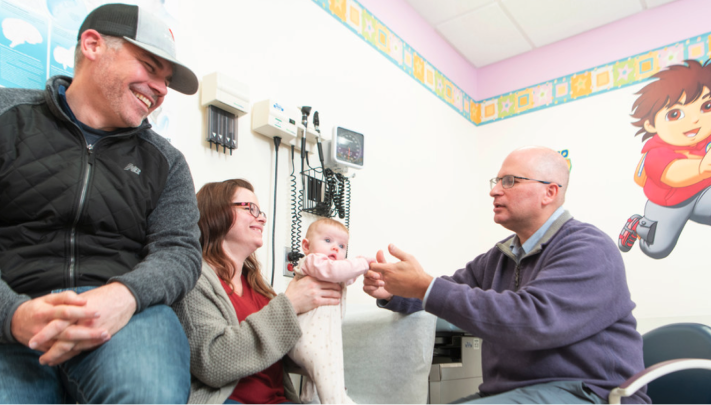
Colorectal
Conditions That Can Develop in Children with Anorectal Malformations

On-going follow-up care, careful monitoring and addressing certain urologic and gynecologic issues that develop in children with anorectal malformations (ARM) early on is key to reducing the risk of developing certain problems and conditions later in life.
These conditions include:
Kidney (Renal) Disease
Bladder Conditions
Urinary Incontinence
Whether or not a child can achieve urinary continence after surgery for their ARM will usually depend on the severity of their condition. In more serious cases, some children were able to achieve continence through Clean Intermittent Catheterization (CIC) of the urethra. CIC refers to the periodic insertion of a thin flexible tube called a catheter through the urethra into the bladder. However, many children with complex cases of ARM will require further urologic reconstructive surgery and/or sacral nerve stimulation (the surgical implantation of a device that sends a low-voltage electrical current to the sacral nerve) to achieve continence.
For children who are unable to tolerate CIC, the surgical creation of a “catheterizeable” channel, a technique called a Mitrofanoff or Monti, can be performed using the appendix or a small area of the bowel.
Testicular Problems in Boys
To treat undescended testes, orchiopexy (surgery to move undescended testes into the scrotum) may be recommended in boys between the ages of 6 to 18 months old. Early intervention helps to preserve as much testicular function as possible. Orchiopexy can be performed at the same time as other surgical procedures in an effort to minimize the number of general anesthetics a child receives.
Recurrent epididymo-orchitis is reported in up to 20 percent of boys with ARM and is associated with lack of bladder control and urinary tract infections. Often reconstructive surgery that divides the bowel and urinary tract will successfully relieve symptoms.
Male Sexual Function and Fertility
For males with ARM, most reproductive issues are likely to be detected early on in a pediatric setting. It is very important to continue with urologic follow up care into adulthood to lessen the impact their condition may have on fertility.
Gynecologic Problems in Females
Around 60 percent of girls born with ARMs will experience some type of gynecological condition or abnormality. Many of these conditions are not diagnosed until puberty especially if the patient has not had the benefit of coordinated care involving a pediatric gynecologist. It is critical to have gynecologic follow-up throughout infancy, childhood, adolescence and adulthood to minimize the risks of potential problems and diagnose any conditions early on.
Managing Gynecologic Conditions in Neonatal Care
A pediatric gynecologist will be an essential part of the medical team that will oversee care for girls who are diagnosed with ARM at birth. Early assessment of the gynecologic anatomy with a combination of physical exam and/or ultrasound will determine the type of interventions that are needed. The pediatric gynecologist may evaluate for abnormalities in the child’s uterine structures, vagina, or cervix The exam may reveal abnormalities that may have been missed if not performed by an experienced pediatric gynecologist. This is critical to timely intervention and reduces the risk of delayed diagnosis at puberty or in adulthood and which could increase potential for endometriosis, uterine pain, infertility and other psychosocial concerns such as negative self-perception and low self-esteem.
In addition, pediatric gynecologists offer counseling to families to openly discuss their daughter’s future reproductive and sexual health. A pediatric gynecologist’s role ensures that sensitive issues will be addressed and that all concerns can be discussed freely.
Managing Gynecologic Conditions in Puberty
Puberty marks the time when the Mullerian structures (the uterus, fallopian tubes, cervix and vagina) become fully matured. During this time, girls with ARM should have regular monitoring with pelvic ultrasounds and be evaluated for physical signs of pubertal progression and cyclic abdominal pain.
Girls with ARM are at risk for menstrual obstruction, ovarian cyst formation, and/or difficulty with tampon insertion. They may require medications to suppress menstrual cycles or referral to a pelvic floor physical therapist.
At puberty, the pediatric gynecologist also begins to provide age-appropriate counseling and anticipatory guidance for each patient regarding gynecologic anatomy, menstruation, tampon use (if desired), and future reproductive and sexual health. Doctors should provide education and encourage open and frank discussions with parents to address any questions and concerns they may have.
Red Flag Signs in Puberty for Girls with ARM
Puberty typically occurs between the ages of 8 and 13. Girls who have not begun showing signs of puberty by age 13, or have not begun to menstruate by age 15 should be evaluated for possible “red flags” of potential reproductive problems including amenorrhea, cyclical abdominal pain, and/or painful menses.
Red flag signs include:
- A lack of functioning of endometrial tissue or the presence of an underdeveloped uterus
- The presence of any menstrual obstruction or outflow tract obstruction
- The presence of pain in patients who are menstruating (dysmenorrhea). This can be caused by a bicornuate (heart shaped) uterus or other abnormality of the uterus as a result of ARM.)
Menstrual obstructions detected in young girls after the onset of puberty are likely to require hormonal suppression and possible surgical intervention. Regular monitoring and early intervention is key because late diagnosis of menstrual obstruction is known to increase the risk of endometriosis, pelvic inflammatory disease, and pyocolpus (accumulation of pus in the vagina).
Female Sexual Function and Fertility
The role of a gynecologist for patients with ARM should offer psychological support and offer private confidential appointments without parents to establish a rapport to address sensitive topics such as these. Because many young girls feel uncomfortable or shy to address sexual concerns with their physician, it’s important to begin having open conversations as soon as possible to address these issues comfortably. Patients should feel comfortable speaking with their gynecologist about sexual concerns, body image, anatomy and sexual function.
Sexual Health and Contraception
The best methods of family planning and contraception will vary for each patient who has had surgical repair for ARM. Their options will depend on their overall health and uterine anatomy. These options, which are typically not addressed with pediatric surgeons, will need to be discussed with a gynecologist who specializes in complex cases.
Pregnancy in Women with ARM
Studies have shown that women with ARM may have difficulty conceiving and have lower birth rates. However, depending on their condition, many women with ARM have normal ovaries and have the potential to conceive biological children through surrogacy.
Women with ARM who become pregnant will likely be considered high risk, thus planned pregnancies are highly encouraged. It is critical that their pregnancy be closely monitored if they have the following conditions:
- Problems with reproductive anatomy such as:
- Uterine didelphus – two uteruses with two separate cervices
- Bicornate uterus – the uterus is heart-shaped
- Vaginal septum – vagina is divided into two sections
- Chronic UTIs
- Kidney disease
- VACTERL associated spine and cardiac conditions. VACTERL stands for vertebral defects, anal atresia, cardiac defects, tracheo-esophageal fistula, renal anomalies and limb abnormalities
- Additional risks associated with both vaginal and surgical delivery
For some patients with ARM, vaginal delivery is safe. However, a planned Caesarean section from an experienced surgeon who specializes in complex obstetric cases may be recommended to ensure the health and safety of both mother and baby. A patient’s obstetrician will consider the safest possible delivery options.
Long-Term Prognosis, Gynecologic Health and Pelvic Organ Prolapse
As women with ARM age, they should be regularly monitored for possible gynecological problems. Some women with ARM may experience:
- Pelvic organ prolapse: occurs when the muscles and tissues supporting pelvic organs are weakened causing pelvic organs to drop into the vagina
- Early menopause: occurs when periods stop prior age 40 and is associated with cardiovascular disease and decreased bone health
Gynecologic care is a vitally important component in the care of women with ARM throughout their entire life cycle. This valuable perspective offers women the best possible outcomes if problems and conditions arise as a result of ARM that cause infertility, sexual dysfunction and body image concerns. A gynecologist’s critical role in the care of women with ARM reduces the number of potential operations they may have otherwise undergone, maintains their overall health as well as greatly improves the quality of their life.






